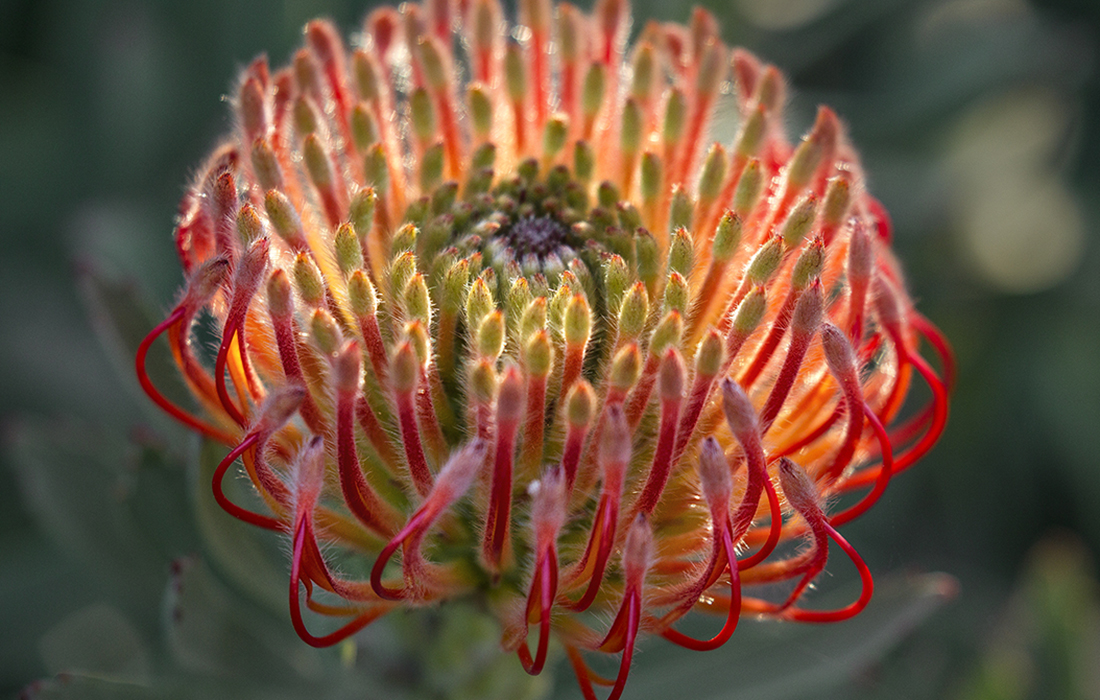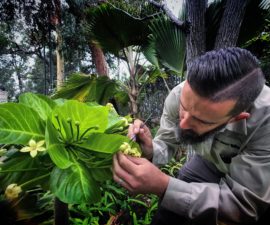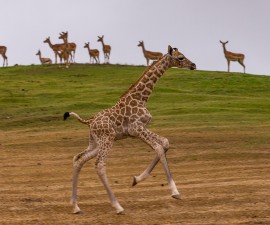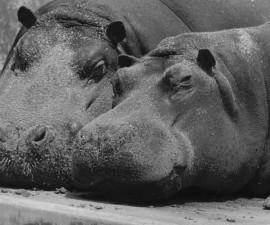BY Eston Ellis
Photography by Tammy Spratt
Take one glance at a blooming protea, and you will likely not be able to look away. These rugged plants with eye-catching, unusual blooms look as if they come not just from another continent, but perhaps from another planet. “When you see a protea, you know right away that this is not a common flower with common petals,” said Mike Letzring, senior plant propagator at the San Diego Zoo Horticulture department. “They have an out-of-this-world look.”
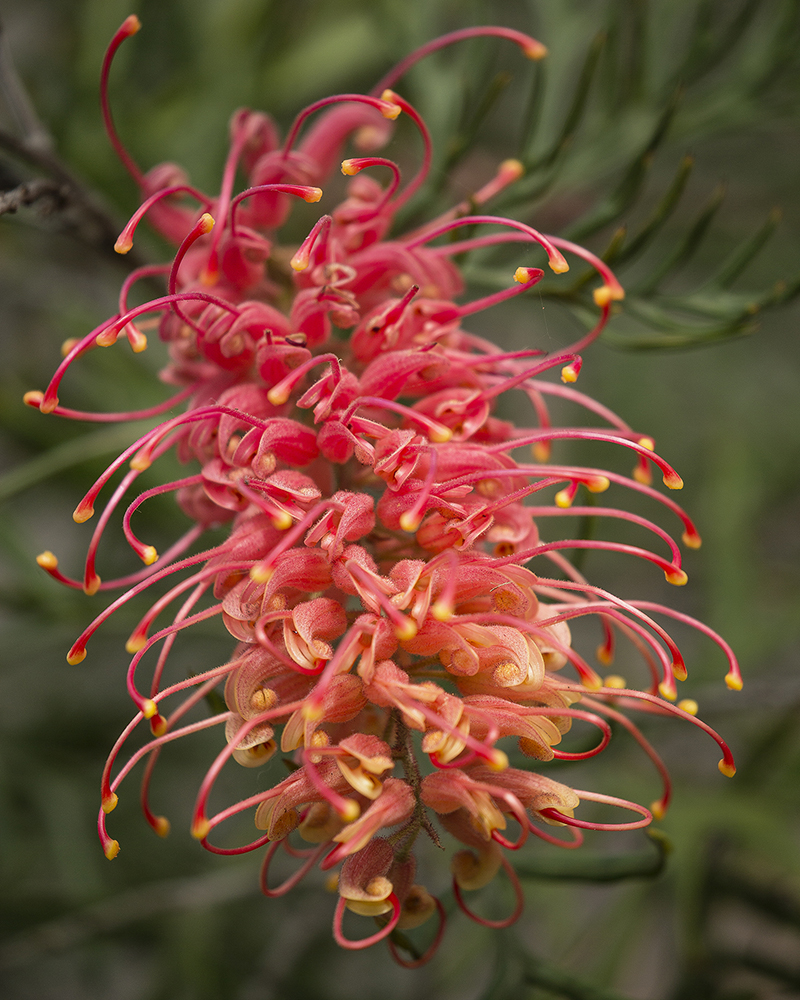
BIRD MAGNET
Big, colorful clusters of blooms on proteas of the Grevillea genus—like the Grevillea banksii pictured—attract sunbirds in Africa and Australia.
With more than 1,200 species in 68 genera, the Proteaceae family is one of the largest and oldest families of evergreen flowering plants, with fossil evidence indicating the existence of proteas more than 100 million years ago. More than 800 species are found in Australia, and there are about 360 species found in southern Africa, most in the Cape Floristic Region—a biodiversity hotspot located in a narrow area in the south and southwestern coastal mountain ranges. The area is also known as the Cape fynbos—fynbos is an Afrikaans word meaning “fine bush.” Of the more than 350 protea species found there, 120 are considered endangered.
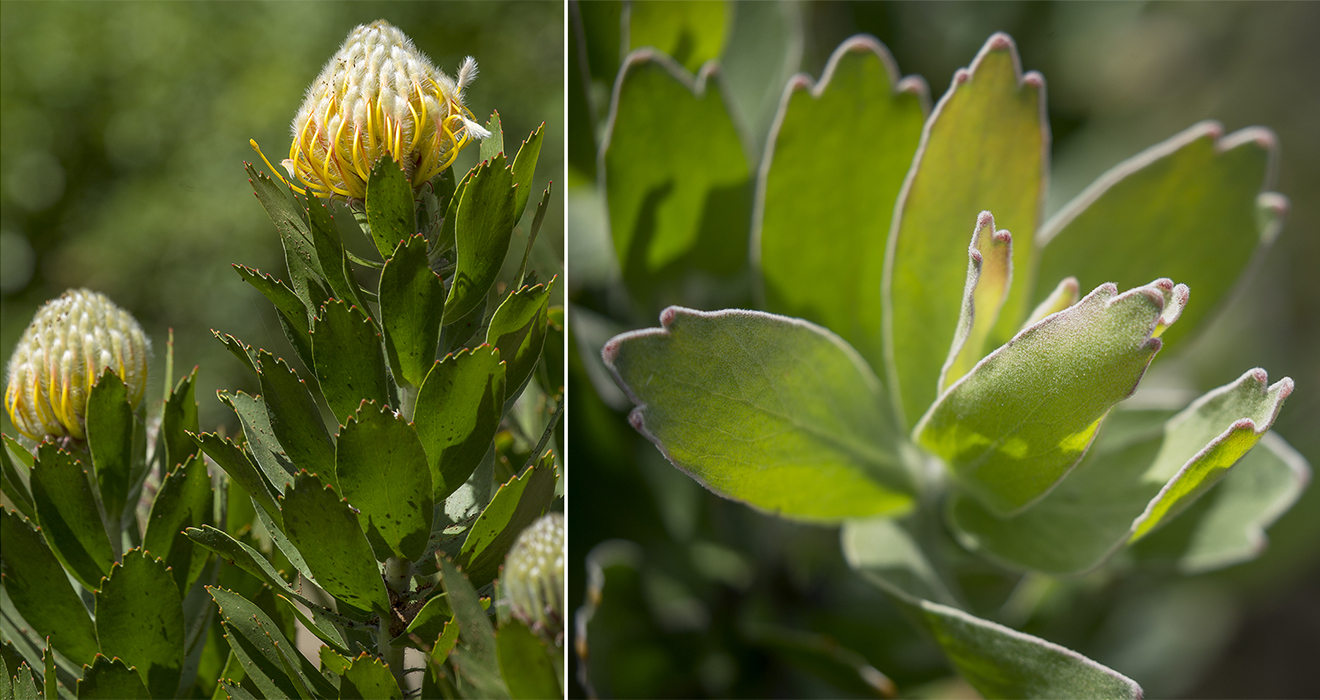
BUILT TO SURVIVE
Tough, leathery leaves on many proteas can absorb moisture in the air, to supplement limited ground surface water. Some proteas produce large amounts of nectar, attracting sunbirds and other pollinators.
The leaves of many protea plants are tough and leathery, but they can absorb moisture from coastal fog to take full advantage of the limited water in their environment. Their root systems have many fine roots near the soil surface, which quickly absorb surface water when it becomes available, as well as the limited soil nutrients. And, because brush fires are common in the fynbos region, many proteas have developed adaptations to survive the heat—including thick bark to insulate the plant, ability to grow in the cracks of protected rock outcroppings, and seedpods that pop open and distribute seeds after a fire.
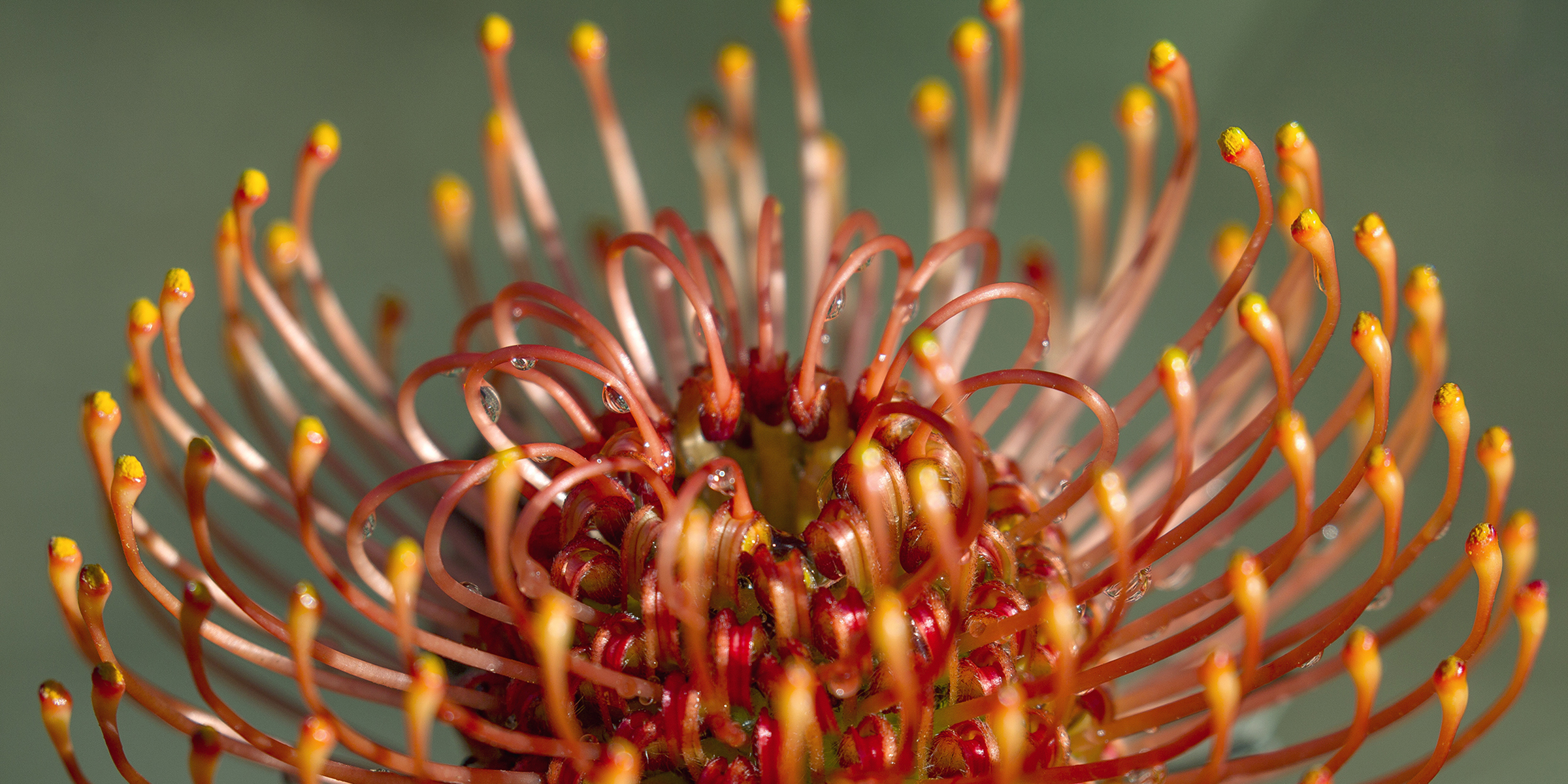
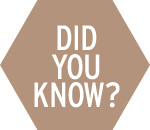 The largest flower in the Proteaceae family is that of the king protea, which can measure up to 12 inches in diameter.
The largest flower in the Proteaceae family is that of the king protea, which can measure up to 12 inches in diameter.
At the Zoo
“Proteas are signature, characteristic plants of the fynbos,” Mike explained. “So, when we decided to create a habitat for African penguins at the Zoo’s new Conrad Prebys Africa Rocks, we knew we wanted proteas there.” In the Cape Fynbos habitat of Africa Rocks, guests can see pincushion proteas Leucospermum cordifolium, including such varieties as orange California Sunshine, reddish-pink Flame Giant, and yellow High Gold. The vivid red, pink, yellow, and orange pincushion proteas are anything but subtle, with showy starburst-shaped blooms. They are composed of tiny flowers that seem to mimic exploding fireworks. Each vibrant flower head is about four inches in diameter, roughly the size of a ripe apple.
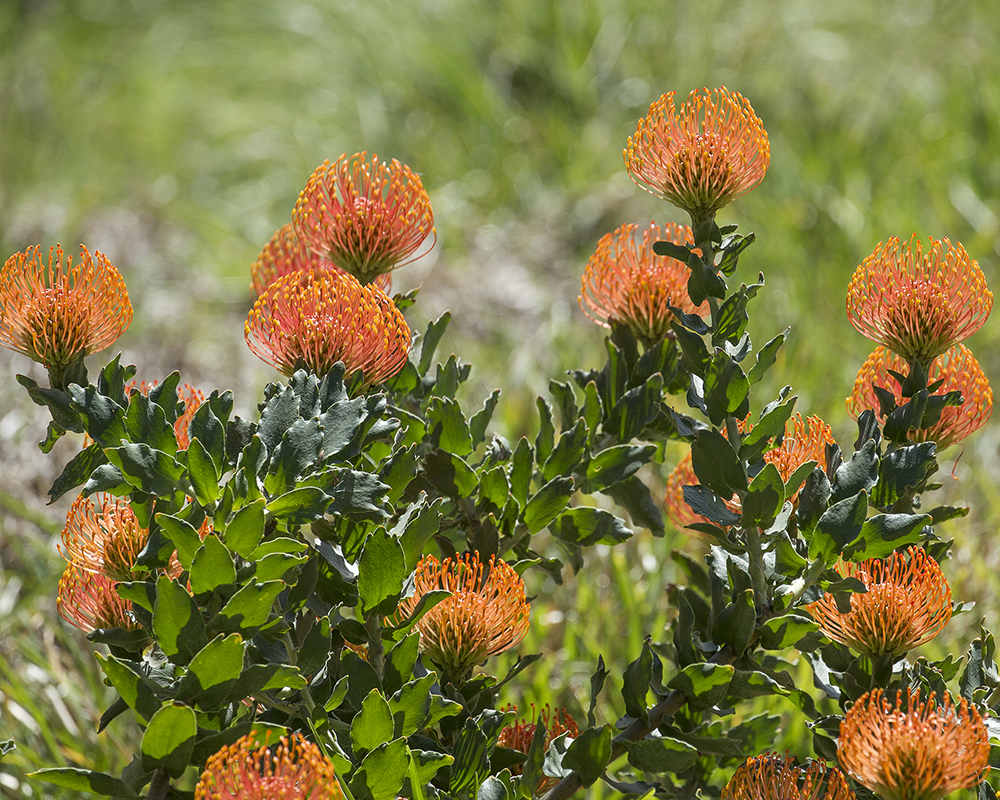
PROFUSION OF PROTEAS
In Africa’s fynbos, proteas—like these orange pincushion proteas—often grow very close together, supporting each other in windy conditions.
While proteas are new to Africa Rocks, they have been in the Zoo’s botanical collection for more than 20 years, and other varieties can be found at Elephant Odyssey and Australian Outback. One protea that guests may see in Elephant Odyssey is the deep red Safari Sunset Leucadendron salignum x lauroleum. With a mature plant width of 6 to 8 feet and stems that can grow 8 to 10 feet tall, this South African native is both big and beautiful.
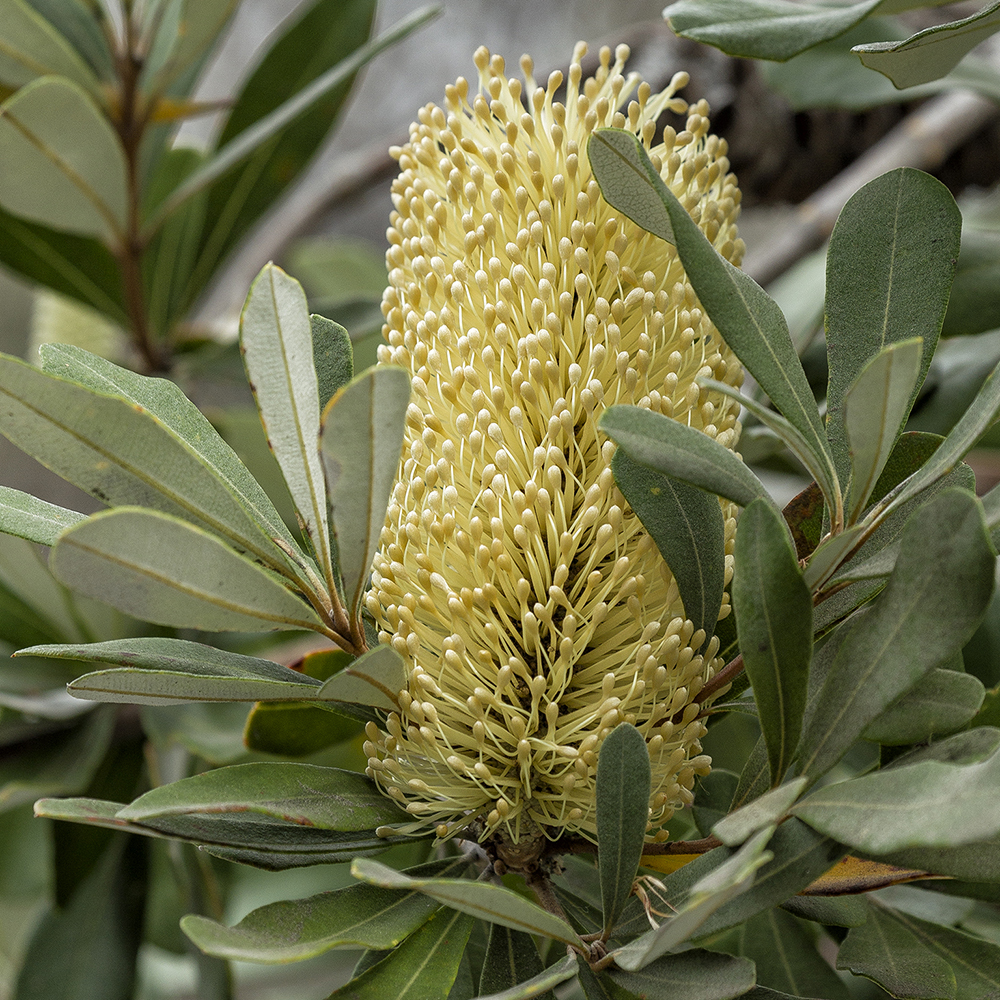
CONEHEAD
The Banksia integrifolia‘s cylinder-shaped flower cluster eventually transforms into a tough, woody “cone” filled with seeds. Those seeds are released and germination is stimulated by brush fires.
Another Proteaceae family member found in Australian Outback is the genus Banksia. These show off sturdy cylindrical, bottlebrush-like flower heads in a wide array of sizes and hues. Each flower head is composed of scores of small flowers and bracts. When they are pollinated, they produce many seeds, protected within hundreds of woody follicles that form a “cone.” Banksias are not only fire tolerant—fire actually helps this plant propagate. When burning cones reach a high temperature (or if cones are put in an oven at 300 degrees Fahrenheit for 20 minutes), they pop open and release scarred seeds that are ready to germinate. Banksias thrive as shrubs or trees, and some can reach heights of 25 feet or more.
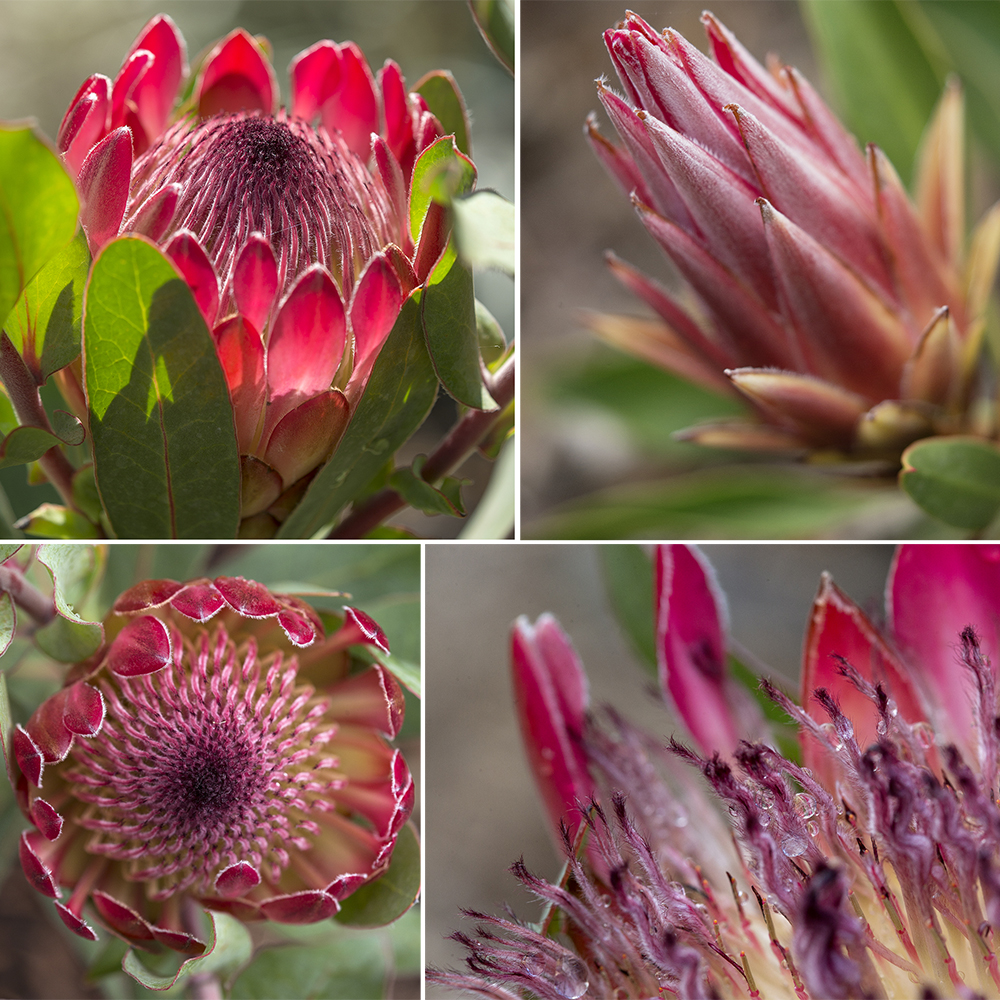
ROCKING THE FYNBOS
At Africa Rocks, Zoo guests will find several members of the Proteaceae family, including pink ice proteas.
Two more proteas found at the Zoo, king protea Protea cynaroides and pink ice protea Protea nerifolia x Susannae (from the Protea genus), have flowers that resemble dappled pink or red artichokes when they are in bud. But when they open, these saucer- to dinner-plate-size floral “targets” really attract attention. A petal-like ring of colorful bracts surrounds a dome-shaped center made up of tiny, almost tubular flowers at the end of white, yellow, or green hair-like stems.
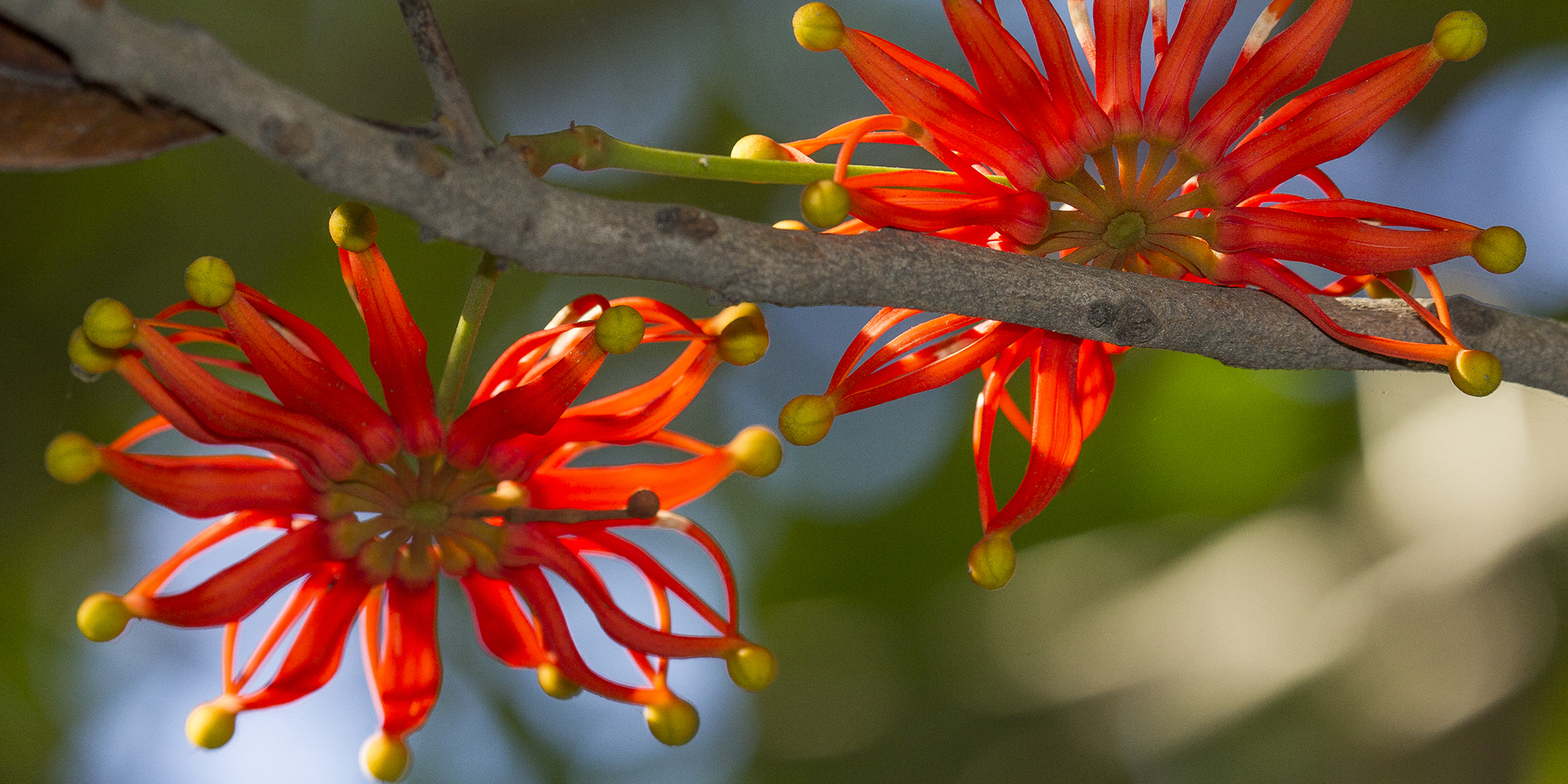
 The tiniest flower in the Proteaceae family is that of the Diastella divaricata, which has a diameter of about 0.4 inch.
The tiniest flower in the Proteaceae family is that of the Diastella divaricata, which has a diameter of about 0.4 inch.
At the Park
For more than 30 years, Banksias and several other types of proteas have grown at the San Diego Zoo Safari Park. “In the Park’s early days, we had a protea garden,” said Robert Thurston, lead horticulturist at the Safari Park. “We were always interested in proteas, as they are a major part of the landscape and habitats we represented at the Safari Park, from southern Africa. Our plantings were at the bottom of a canyon near the Conifer Arboretum. Horticulturist Chuck Mastrangelo, who retired earlier this year after working for 43 years in Horticulture at the Park, was responsible for establishing the protea garden.”
About 15 years ago, the garden transitioned into a more open space in preparation for future redevelopment, but some of the spectacular plants continue to thrive near the Conifer Arboretum, including several Banksias over 20 feet tall. The many large protea family members that can be found at the Park include a firewheel tree Stenocarpus sinuatus, a Banksia integrifolia with pale yellow, cone-shaped flowers, silky oak Grevillea robusta, and a macadamia nut tree Macadamia integrifolia.
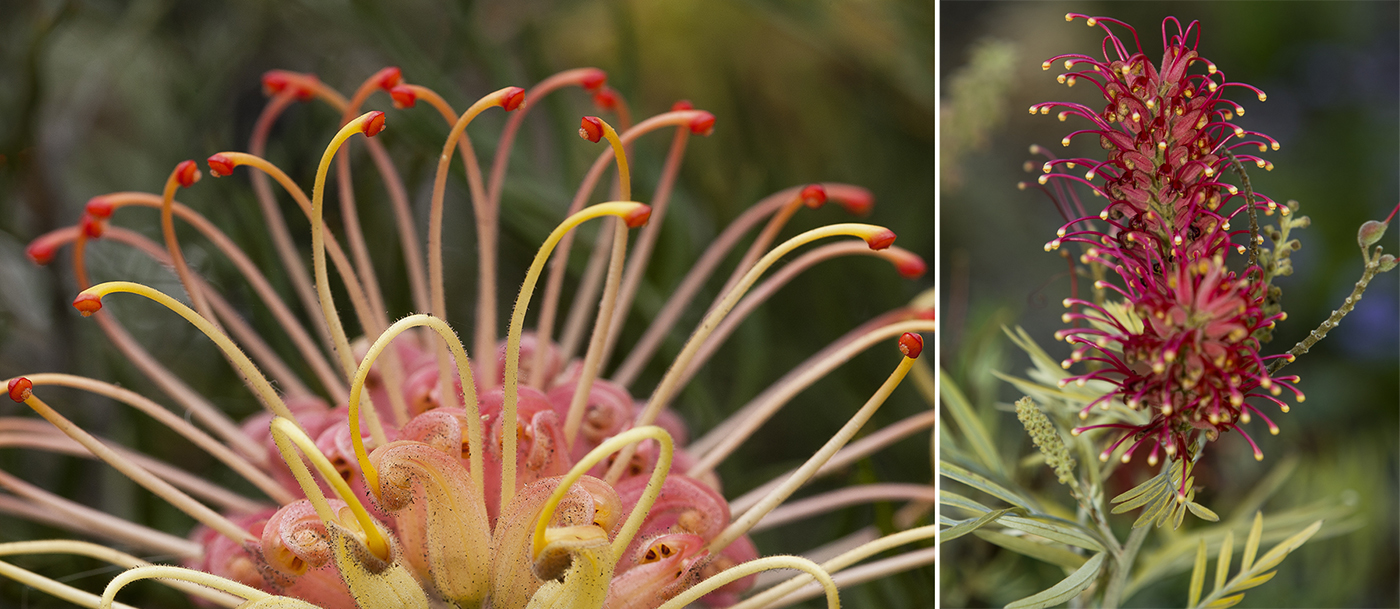
ALMOST ENDLESS VARIETY
There are more than 250 species of Grevillea proteas—including ground covers, shrubs, and trees.
Silver tree proteas Leucadendron argentum are showy shrubs or trees that use the sun to grab the spotlight. Long hairs on each of this protea’s narrow leaves reflect sunlight to create shimmering silver streaks. The plant can also produce a root beer-like scent to attract beetles that pollinate this unique species.
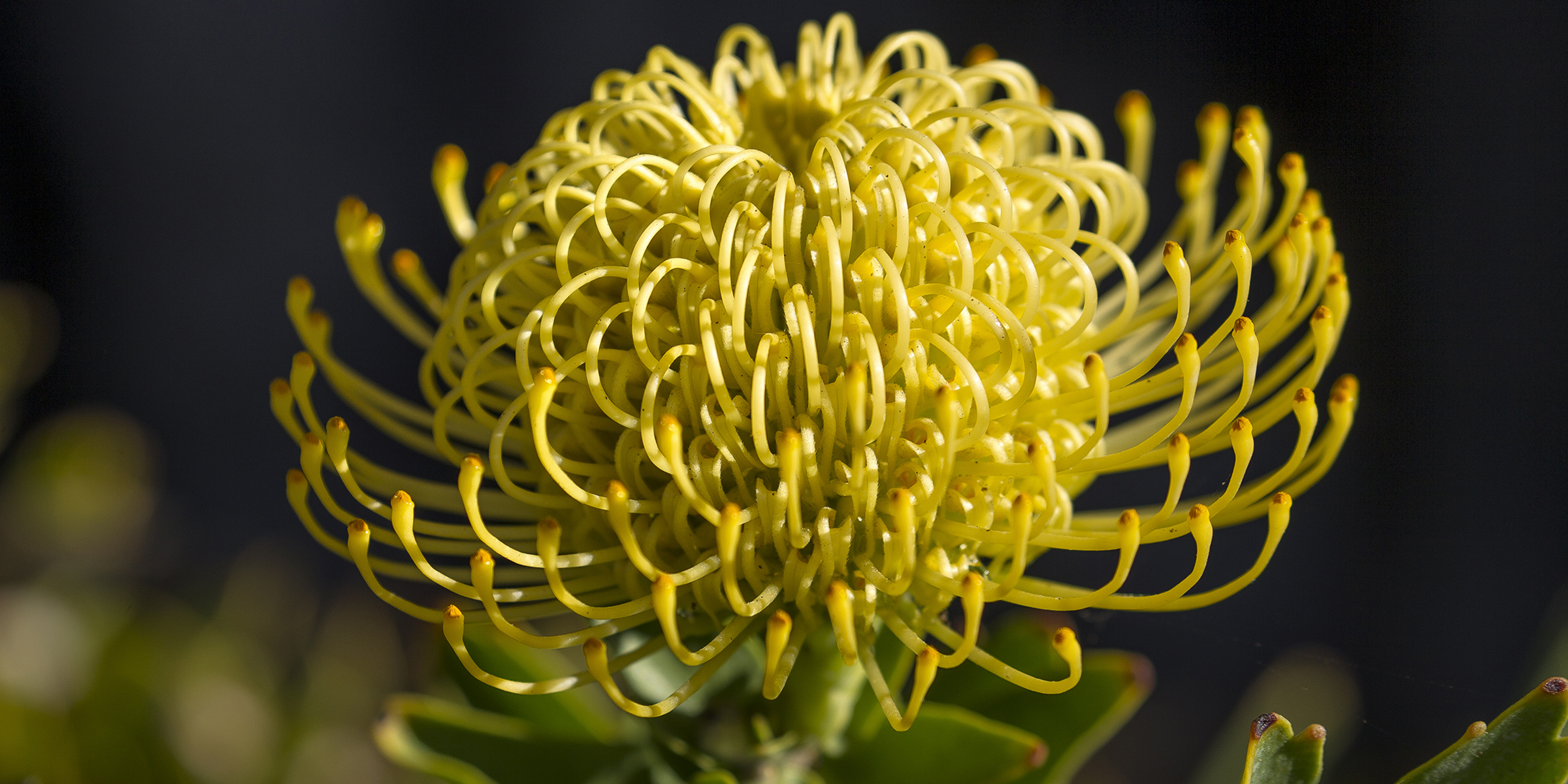
 The best-known edible in the Proteaceae family is the macadamia nut.
The best-known edible in the Proteaceae family is the macadamia nut.
Growing Proteas
Proteas are well adapted for life in the fynbos. They can grow in dry, acidic soil, and they need very little water. They can put down roots on steep slopes, in salt-laden coastal air, and in fast-draining soil that does not retain moisture. Proteas not only exist in this habitat, but they flourish—growing tall and providing food and shelter for a variety of animals.
Some proteas, such as the sugarbush Protea repens, produce large quantities of nectar—so much that it was once gathered by European settlers in South Africa, who boiled it into a syrup used as a sugar substitute and cough remedy. Protea pollinators include birds, insects, and small mammals, such as pygmy possums, that feed on that nectar. One insect species, the protea beetle Trichostetha fascicularia, is particularly fond of the plant, and up to 2,000 of these beetles have been counted gathering on just one protea flower head. “In the fynbos, sunbirds are the protea’s main pollinators,” Mike said. “Here in Africa Rocks, in Southern California, our local hummingbirds are attracted to the nonnative protea.”
While proteas may not seem like a natural choice for a Southern California backyard garden, they can be grown here. “Our climate is similar to the Mediterranean climate of the South African coast,” Mike said. Commercial growers in North San Diego County have been raising fields of proteas for the cut flower market for more than a decade. The plants are grown in fast-draining soil—typically on sunny hillsides—and they are sparsely watered with drip irrigation systems.
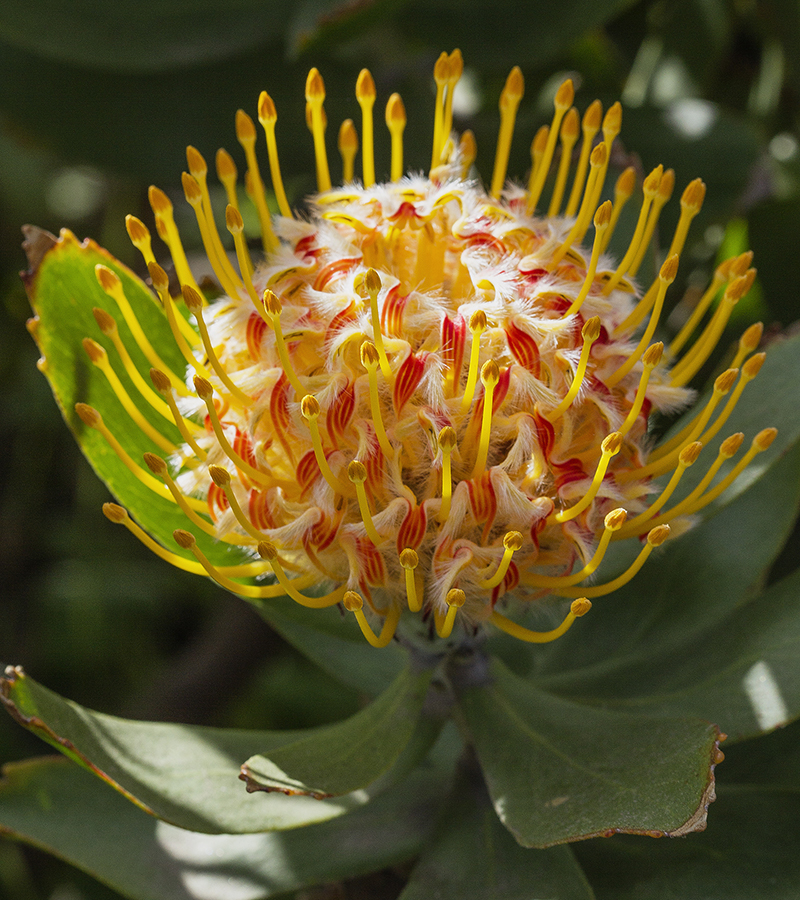
EYE-CATCHING GIANTS
Proteas in the Leucospermum genus—which includes pincushion proteas—come in a wide array of colors, and plants typically range from 1.5 to 6 feet tall.
The soil of Southern California is much different from the acidic soil of the fynbos, so those different pH levels need to be addressed. “Proteas may not be a good choice for a beginning gardener, but feeding them with nitrogen—no phosphorous—and adding mulch and compost makes a big difference,” Mike said. “They need good drainage and good soil aeration,” Robert added. “They don’t like standing water; they like being grown around drip lines, on a gentle slope. They need full sun and soil with very little clay, but some organic material. Proteas are pretty drought tolerant, because of their fine root system—but those fine roots near the surface mean that you cannot disturb the soil around the plants.”
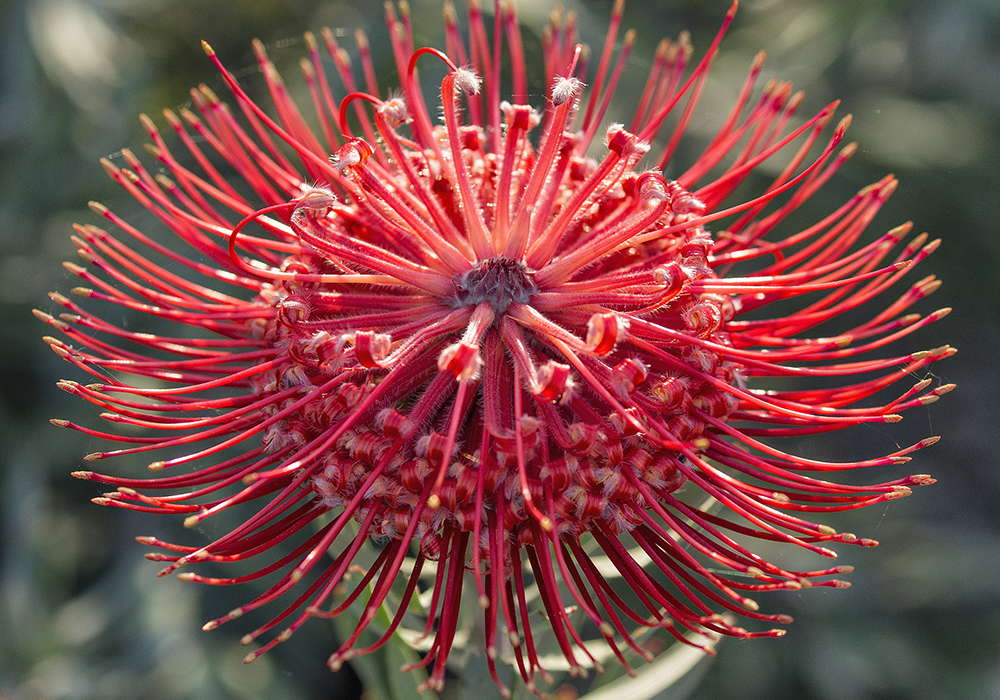
LOOK SHARP
Pincushion proteas get their name from the appearance of their cluster of tiny flowers with long, needle-like styles and stigmas at the end.
“One woman I know who grows them successfully has what she calls a ‘benign neglect’ approach,” Mike said. “Water them once a week, and leave them alone. The rule with dry climate plants is ‘less is more’—you can always water more later if they need it, but you can’t take it back if they get too much.” While proteas are tough and drought resistant, they can die quickly if they get too much water (or no water at all), if they are fertilized like traditional garden plants, or if they experience extreme heat or freezing temperatures.
All Together Now
“In Africa, the plants in the fynbos grow very close together,” Mike said. “They are so close that they actually hold each other up, especially in windy conditions.” The leaf litter produced by those closely spaced plants helps provide protection for the plants’ fine, close-to-the-surface roots, and a sun barrier. With that in mind, the proteas in Africa Rocks are also closely spaced, to create that natural support system.
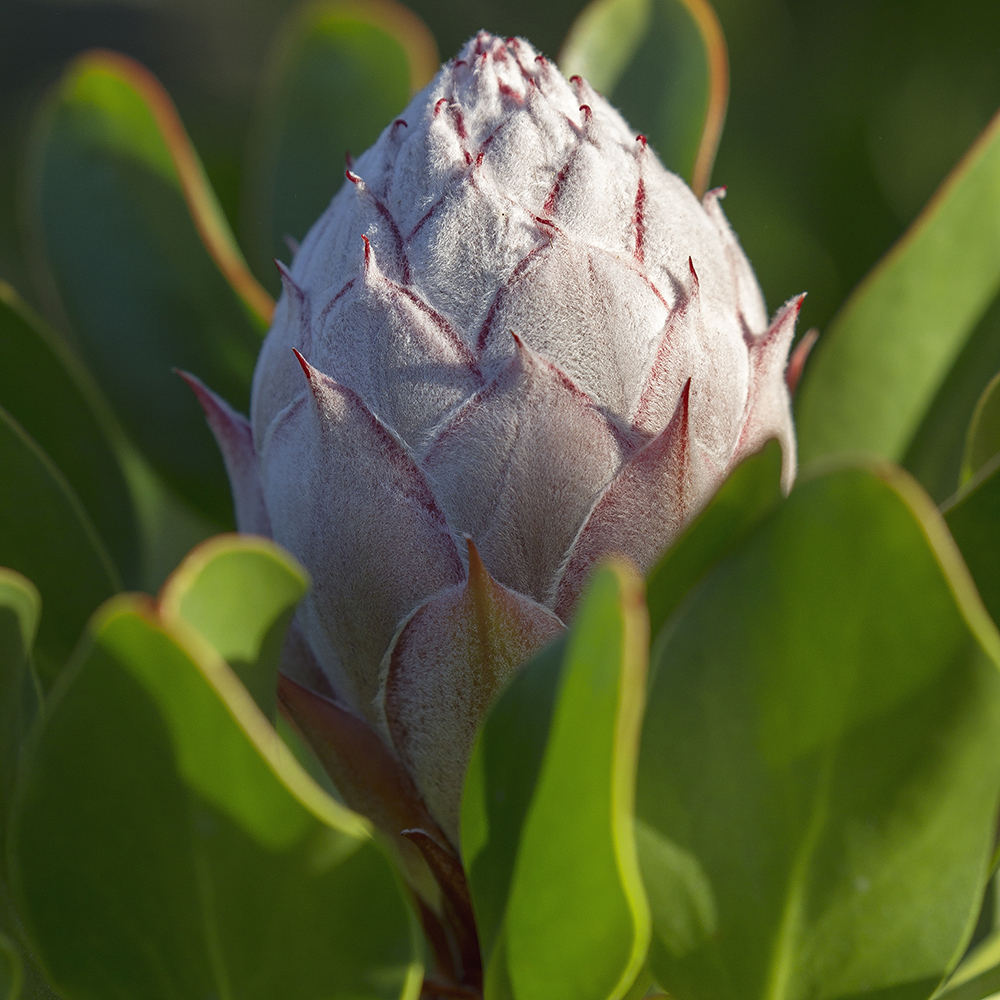
PINK ARTICHOKE?
Before it opens, the large bud of a king protea looks something like an artichoke. The open flower can measure up to 12 inches in diameter.
“Proteas go through a growth spurt, all of a sudden,” Mike said. “And when they put out that flush of growth, they are not easy to train. You can stake them and prune them to try and get the plant shape you want, but they seem to have a mind of their own: if they are determined to grow left and you want them to go right, they’ll still go left. It’s like they have a little rebellious teenager in them.”
Proteas get their name from Proteus of Greek mythology, the son of Poseidon. Proteus had the power to transform himself into many forms—and his name seems quite appropriate for colorful members of the Proteaceae family, which come in a dazzling variety of unusual shapes and sizes. On your next visit to the Zoo or Safari Park, be sure to look for our proteas, and discover their eye-catching, otherworldly beauty for yourself.

